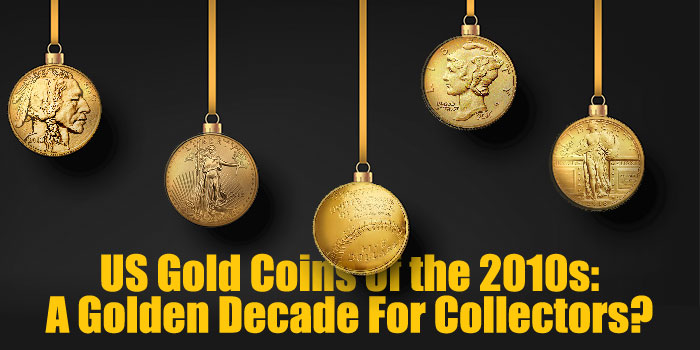
By Joshua McMorrow-Hernandez for CoinWeek …..
As 2019 winds down, so, too, does the decade of the 2010s. It was a colorful period for the United States Mint, which produced a staggering variety of numismatic gold coinage for collectors. Coin collectors have been busy trying to keep up with the Mint’s rapidly expanding gold catalog, and it hasn’t always been easy for most collectors to keep pace.
Pricewise, the decade started off strong for gold, which rode post-recession worries and unstable markets into record-price territory during the early 2010s. In August 2011, the price of gold per ounce crested above $1,900 USD and at one point appeared realistically poised to cross the $2,000 threshold. However, prices slipped and began a long decline to as low as $1,050 in late 2015.
Many numismatists found benefits to buying collectible gold coins during both market highs and lows. In the early 2010s, many individuals and market analysts thought that gold was on its way to $5,000 per ounce and above. So buying gold when it was $1,500 or even $1,900 per ounce might have seemed like a last-chance opportunity to buy gold coinage while it was still “affordable”.
And surely, many collectors who bought gold when it dropped closer to the $1,000 level thought they were getting a steal of a deal – especially when prices were nearly twice as high just a few years earlier. Now, with gold hovering around $1,500 and with the advantage of hindsight, it’s clear that those collectors who bought gold coins at $1,050 or $1,100 probably made out pretty well after all.
Throughout the decade of the 2010s, the U.S. Mint saw robust demand for collectible gold coins, and they kept collectors busy by offering an incredible number of gold issues. Let’s examine each of the numismatic gold series the United States Mint issued over the course of the last decade and see how well they have performed in the marketplace since their release.
American Buffalo Gold Coins
While the American Eagles reign supreme as the most popular United States precious metals series, the American Buffalo series is right up there. The American Buffaloes are so named because they feature the beloved James Earle Fraser design that appears on the five-cent coins issued from 1913 through 1938, with the obverse featuring the bust of a Native American chief and the reverse carried by the titular “buffalo” (really an American bison).
 Originally issued in 2008, these .9999-fine 24-karat gold bullion coins are offered in both Uncirculated and Proof formats. While initially offered in a variety of denominations, the American Buffalo coins have been issued only in a $50 face value format since 2009. The coins, struck at the West Point Mint, have been offered at various prices depending on the nature of the prevailing gold markets as well as production costs.
Originally issued in 2008, these .9999-fine 24-karat gold bullion coins are offered in both Uncirculated and Proof formats. While initially offered in a variety of denominations, the American Buffalo coins have been issued only in a $50 face value format since 2009. The coins, struck at the West Point Mint, have been offered at various prices depending on the nature of the prevailing gold markets as well as production costs.
Most of the Proof versions issued for collectors have seen relatively stable price performance in the years since their release. A few notables do stand out, though. These include the 2012-W, the 2013-W, and the 2013-W Reverse Proof American Buffalo gold coins. As compared to most other Buffaloes from the period, these pieces saw somewhat lower mintages, which, against strong demand for the entire series, means these pieces see positive price performance on the secondary market.
Overall, American Buffalo gold coins are a popular alternative for collectors who want to collect gold coinage that celebrates some of the beautiful, artistic designs from yesteryear. And, as will be seen with other collectible gold coins from the 2010s, the American Buffalo wasn’t the only new United States gold coin release with a familiar design.
American Gold Eagles
The nation’s longest-running gold bullion series saw exceptional demand during the 2010s from both investors and collectors. The four different American Gold Eagle denominations, including the $5 face value tenth-ounce, $10 quarter-ounce, $25 half-ounce, and $50 one-ounce coins, have been regularly produced in Proof format for collectors since the 1980s. However, numismatists were presented with a vast array of collectible options among the Gold Eagles in the 2010s – and virtually all are found among the one-ounce $50 gold piece.
Several $50 American Gold Eagles were issued in Burnished (Uncirculated) format throughout the past decade, with each bearing a “W” mintmark from West Point, along with its characteristic lustrous, matte finish. These Burnished coins, along with the more conventional and consistently offered Proofs, provided collectors with several excellent opportunities to expand their gold collections with handsome, high-quality one-ounce American Eagle gold coinage in the 2010s.
There were few such collectible offerings to be found within the lower denominations of the American Gold Eagle family, save for the regular Proofs. However, one interesting variety was found with the bullion-quality 2015 $5 tenth-ounce coin, some examples of which feature narrow reeding, as applied to the coin by a collar originally intended for the 2008 American Buffalo tenth-ounce gold coins.
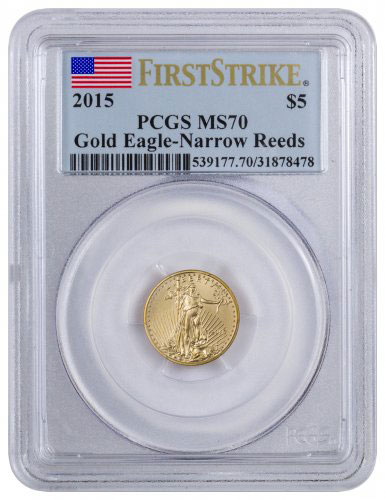 Mintage estimates are indeterminate for the 2015 Narrow Reeds $5 gold coin, but this variety has proven rare in the marketplace nonetheless. Price trends for these pieces are largely independent of their spot value. Several listed on online auctions are trading for between $450 and $650 in grades of MS69 and MS70 – multiples of their intrinsic metal value.
Mintage estimates are indeterminate for the 2015 Narrow Reeds $5 gold coin, but this variety has proven rare in the marketplace nonetheless. Price trends for these pieces are largely independent of their spot value. Several listed on online auctions are trading for between $450 and $650 in grades of MS69 and MS70 – multiples of their intrinsic metal value.
The current American Gold Eagles are poised to see increased collector demand in the next years ahead. The United States Mint recently announced that it will replace the current reverse design by Miley Busiek [The maiden name of sculptor Miley Frost, kept here for clarity’s sake. —CoinWeek], which features a family of eagles. Taking the place of this original design will be an unspecified motif that incorporates unpublicized security and anticounterfeiting enhancements. Presumably, the new motif will involve eagle imagery, but any changes will render the long-running Busiek design obsolete and create a numismatic bookend for the Family of Eagles reverse subtype in 2020.
American Liberty High-Relief Gold Coins
Mint officials knew they were on to something good following the successful release of the MMIX (2009) Ultra High Relief Gold Coin, which features the classic Augustus Saint-Gaudens design seen on the $20 gold double eagle struck between 1907 and 1933. So a few years later, the U.S. Mint began its biennial American Liberty High-Relief gold coin series, launched to emphasize “creating a ‘modern’ Liberty that reflects the nation’s diversity,” as described by Mint spokespersons.
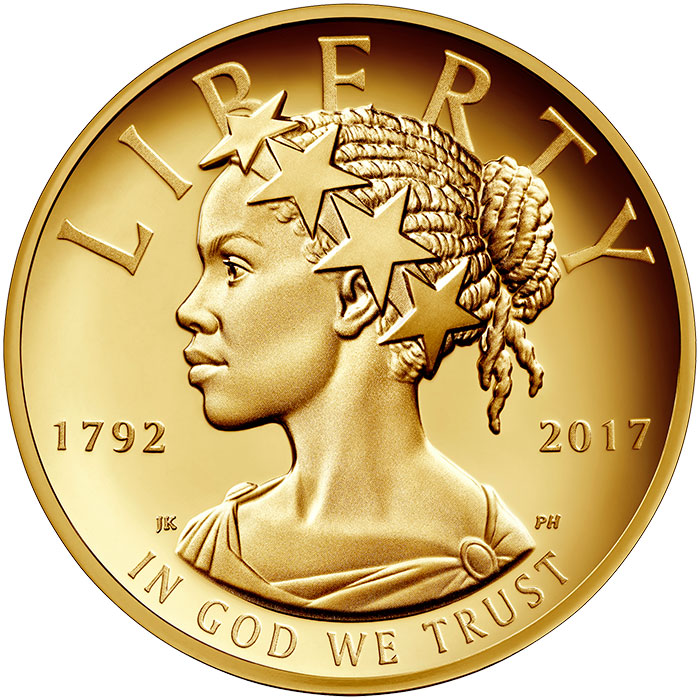 Denominated with a face value of $100, the coin debuted in 2015 with a striking design of a standing Miss Liberty holding a flaming torch and an American flag. Yet as patriotic a series as it has been, some of the latter issues have stirred numismatic headlines. The 1792-2017-W $100 release was the first United States coin to feature Miss Liberty with distinctly African American features, causing some to decry the coin for departing from the long-held tradition of depicting Miss Liberty as a Caucasian woman. Meanwhile, the 2019-W $100 American Liberty High-Relief Gold Coin depicts Miss Liberty as an Asian American woman, a design that seems to have received less outward criticism.
Denominated with a face value of $100, the coin debuted in 2015 with a striking design of a standing Miss Liberty holding a flaming torch and an American flag. Yet as patriotic a series as it has been, some of the latter issues have stirred numismatic headlines. The 1792-2017-W $100 release was the first United States coin to feature Miss Liberty with distinctly African American features, causing some to decry the coin for departing from the long-held tradition of depicting Miss Liberty as a Caucasian woman. Meanwhile, the 2019-W $100 American Liberty High-Relief Gold Coin depicts Miss Liberty as an Asian American woman, a design that seems to have received less outward criticism.
However, artistic controversies will carry the $100 coin into the 2020s, as the United States has announced its next installment for this program will depict allegorical Liberty not in human form but, rather, equine. As of press time, the greenlit obverse design for the 2021-W American Liberty High Relief gold coin features a bucking mustang, a design met with positivity from animal lovers and those who wish to see our coinage take a drastic step away from traditional allegory, while others wish to see Liberty remain embodied by a human.
While at least two of the four designs either struck or proposed for this ambitious $100 gold coin series have received sufficient press due in part to their artistic merits, it seems the overall sales results for this series offer a mixed bag of results.
According to the Mint, the 2015-W coin resembling a more traditionally styled Liberty sold 49,325 pieces, yet the 1792-2017-W saw just 30,864 pieces distributed through November 3, 2019.
A 2018 tenth-ounce complement to the 1792-2017-W one-ounce coin, aimed at getting its groundbreaking design into more hands, saw 29,771 examples distributed through November 3, 2019. At this time, there is too little information available on its sales to speculate on how well the 2019-W gold coin will perform overall. However, the previous two issues are trading in the secondary market for relatively small premiums over melt, suggesting numismatic demand remains comparatively soft for these coins.
First Spouse Gold Coins
The 2010s kicked off with the continued production of First Spouse gold coins, which were first released in 2007 concurrent to the Presidential $1 coin series. The First Spouse gold coins, featuring the first ladies of each of the presidents honored on the dollar coins (when appropriate), consist of one-half ounce of .9999-fine 24-karat gold and carry a face value of $10. During most years of the First Spouse series, four different designs were released, concluding with the Nancy Reagan First Spouse gold coin issued in 2016.
 While the series is largely considered a bullion program, the First Spouse gold coins have a significant numismatic component. They serve not only as the more expensive arm of the base-metal Presidential $1 coin series, but they were also issued in both Uncirculated and Proof formats. And the series did see some demand among the small but dedicated number of collectors who sought First Spouse coinage.
While the series is largely considered a bullion program, the First Spouse gold coins have a significant numismatic component. They serve not only as the more expensive arm of the base-metal Presidential $1 coin series, but they were also issued in both Uncirculated and Proof formats. And the series did see some demand among the small but dedicated number of collectors who sought First Spouse coinage.
Still, the program, by and large, did not see an overwhelmingly large customer base. There were 40 separate designs (double that to 80 coins when counting both the Uncirculated and Proof formats). In all, that’s a lot of expensive gold to collect, putting the entire series out of financial reach for the vast majority of coin collectors.
Making matters even more challenging for most collectors was the relatively rapid pace at which they were released. At a clip of four per year during most years, a new half-ounce gold installment for the series was rolling off the presses about every 90 days. Issue prices are all over the map for these coins, as most were struck during an erratic period in the marketplace in terms of gold prices. Suffice it to say, most of these coins were issued at prices between $600 and $1,000 apiece – an expensive bullet to bite four times a year.
Today, most of the First Spouse coins trade at or very close to melt values. Due in large part to the relatively low demand for these coins from the onset, many have low mintages – a good thing for collectors. Several of the Uncirculated pieces saw mintages of fewer than 2,000 pieces, and even many of the more popular Proof varieties were minted to the tune of less than 2,500 units. But while many examples are genuinely scarce, there are a few notable highlights from the series worth keeping an eye on.
 The 2014-W Eleanor Roosevelt $10 gold coin is emerging as a key issue due to the piece’s relatively low mintage of 1,886 Uncirculated specimens and 2,377 Proofs, coupled with strong demand thanks to Roosevelt’s enduring popularity. Similarly, the 2015-W Jacqueline Kennedy and 2016-W Nancy Reagan coins attract a steady number of collectors both within the numismatic hobby and from admirers of these two popular first ladies. While the Kennedy pieces have comparatively high mintage numbers in the context of the First Spouse series, with 5,491 struck in Uncirculated format and 11,222 made in Proof, the Reagan coins saw just 2,009 Uncirculated specimens and 3,548 Proofs – decidedly low given demand.
The 2014-W Eleanor Roosevelt $10 gold coin is emerging as a key issue due to the piece’s relatively low mintage of 1,886 Uncirculated specimens and 2,377 Proofs, coupled with strong demand thanks to Roosevelt’s enduring popularity. Similarly, the 2015-W Jacqueline Kennedy and 2016-W Nancy Reagan coins attract a steady number of collectors both within the numismatic hobby and from admirers of these two popular first ladies. While the Kennedy pieces have comparatively high mintage numbers in the context of the First Spouse series, with 5,491 struck in Uncirculated format and 11,222 made in Proof, the Reagan coins saw just 2,009 Uncirculated specimens and 3,548 Proofs – decidedly low given demand.
Gold Commemoratives
When the United States resurrected gold coinage in 1983, five decades after President Franklin Delano Roosevelt’s Executive Order 6102 eliminated gold coins from the Mint production line in 1933, the first new gold coin of the modern era was a commemorative $10 eagle honoring the 1984 Summer Olympic Games in Los Angeles.
Fast-forward more than 25 years, and the 2010s would see a slew of artistic, even ground-breaking, commemorative gold coinage.
 All gold commemorative coins of the 2010s has been issued with a nominal value of $5 and include the following issues:
All gold commemorative coins of the 2010s has been issued with a nominal value of $5 and include the following issues:
- 2011 Medal of Honor
- 2011 U.S. Army
- 2012 Star-Spangled Banner
- 2013 5-Star Generals
- 2014 National Baseball Hall of Fame
- 2015 U.S. Marshals Service 225th Anniversary
- 2016 Mark Twain
- 2016 National Park Service 100th Anniversary
- 2017 Boys Town Centennial
- 2018 Breast Cancer Awareness
- 2019 American Legion 100th Anniversary
- 2019 Apollo 11 50th Anniversary
While most of the dozen $5 gold coins from the 2010s are somewhat conventional in nature, a few stand out from the rest. The 2014 National Baseball Hall of Fame $5 gold coin was, along with its counterpart half dollar and silver dollar, the first United States coin to be struck in a curved format. The concave obverse depicts a catcher’s glove and the convex reverse showcases a baseball. A total of 17,674 uncirculated $5 gold coins and 32,428 proof specimens were distributed with regular issue prices of $436.90 for the former and $441.90 for the latter.
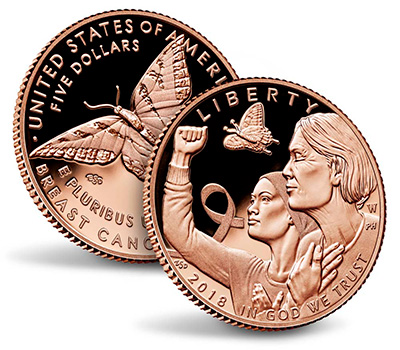
Other notable entries among the $5 gold commems include the pink-colored 2018 Breast Cancer Awareness $5 gold coin, which was struck in an 85% gold, 14.8% copper, 0.2% zinc alloy to achieve the coin’s “pink gold” hue. The proofs were originally issued for $431 and the uncirculated pieces were offered by the Mint for $421. Through January 2019, a total of 10,386 Proof examples were sold and just 4,466 Uncirculated distributed. While these are rather dismal numbers as compared to the 50,000 total pieces authorized across all $5 Breast Cancer Awareness coins, perhaps time may be kind to these low-mintage coins if collector demand ever increases.
The verdict is still out for the 2019 Apollo 11 50th Anniversary gold coin, which revisits the curved format first seen with the Baseball Hall of Fame coins five years earlier. Regular issue prices were initially set at $408.50 for the uncirculated edition and $418.50 for the proof.
In all, the $5 gold commemorative coins of the 2010s have performed about as well in the secondary market as any of the other modern commems – sluggishly. Sales are strong during the initial release but then demand collapses in the secondary market.
Most $5 gold commemorative coins trade in the wholesale marketplace for pennies over melt. However, the 2014 National Baseball Hall of Fame gold coins have enjoyed sustained collector interest due to their high crossover appeal into the lucrative sports collectibles arena, not to mention significant mass promotion from coin dealers.
2014 Gold Kennedy Half Dollar
Along with becoming the nation’s first official gold coin with a face value of less than one dollar, the 2014-W 50th Anniversary Gold Proof Kennedy half dollar was perhaps the first to inspire fights in the streets of Rosemont, Illinois. That’s what happened when the coin was released in 2014 during the American Numismatic Association (ANA) World’s Fair of Money, where the United States Mint released some of the first examples.
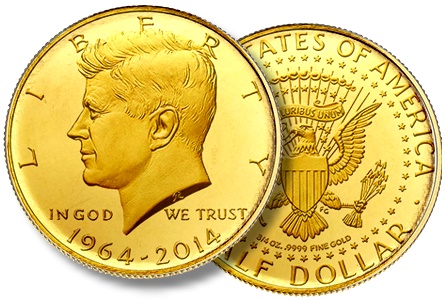
Waiting for the release of the gold Kennedy coin, crowds lined up around the convention center – much to the delight of mainstream news media who covered the launch of this coin. Reporters were also on the scene as confrontations broke out between mostly non-collectors who were paid by enterprising coin dealers attempting to circumvent the Mint’s initial sales restriction of one coin per person per day. Outbreaks of violence–including a stampede that erupted when the Mint store released the coin for sale on August 5–caused the Mint to suspend in-person sales of the gold Kennedy half dollar at the ANA show.
The initially limited supply of gold Kennedys inspired strong secondary market bids on the Rosemont bourse floor, with several dealers paying some $3,000–almost three times the U.S. Mint’s $1,240 issue price–for the proof three-quarter-ounce gold coin. After the hype simmered down and mintages went up, bids naturally dropped, with prices eventually settling much closer to melt value. A total of 73,772 gold Kennedy half dollars were struck, and most dealers (at the time of publication) are selling them at prices little above spot.
2016 American Liberty Centennial Gold Coins
The United States Mint has clearly enjoyed success in reviving classic designs on its newer gold coins (see above). So the precedent was well established by 2016, in time for the American Liberty Centennial gold coins that resurrected popular designs from the Mercury dime, Standing Liberty quarter, and Walking Liberty half dollar.
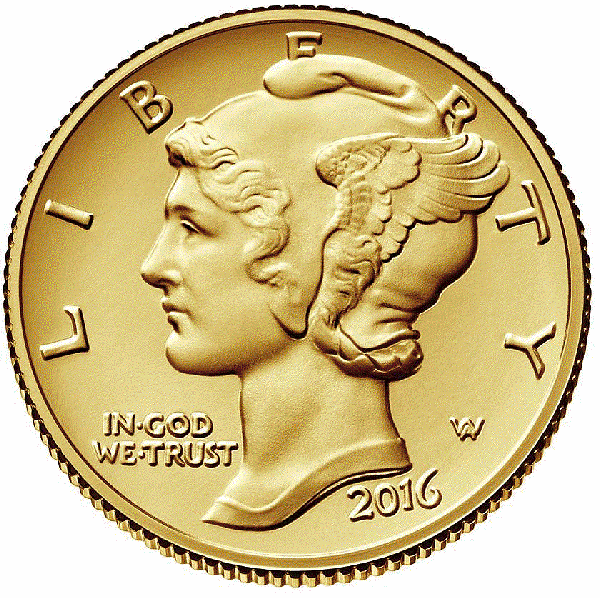 The release of the American Liberty Centennial gold coins coincided with the 100th anniversary of the three series that debuted in 1916, offering faithful reproductions of Adolph A. Weinman’s Mercury dime and Walking Liberty half dollar as well as Hermon A. MacNeil’s Standing Liberty quarter. With the exception of rather discreet AU markings on the coins denoting their gold content, the three gold coins are relatively close artistic replicas of the originals they emulate. However, the difference in weight between the 90% silver composition of the originals and the heavier 24-karat gold used in the 2016 coins made it impractical to exactly mimic the physical dimensions of the former coinage. Still, the new gold pieces excellently approximate the size and heft of the three silver coins.
The release of the American Liberty Centennial gold coins coincided with the 100th anniversary of the three series that debuted in 1916, offering faithful reproductions of Adolph A. Weinman’s Mercury dime and Walking Liberty half dollar as well as Hermon A. MacNeil’s Standing Liberty quarter. With the exception of rather discreet AU markings on the coins denoting their gold content, the three gold coins are relatively close artistic replicas of the originals they emulate. However, the difference in weight between the 90% silver composition of the originals and the heavier 24-karat gold used in the 2016 coins made it impractical to exactly mimic the physical dimensions of the former coinage. Still, the new gold pieces excellently approximate the size and heft of the three silver coins.
The tenth-ounce gold 2016-W Mercury dime, issued for $205 in April 2016, was a quick sellout, with all 124,885 pieces distributed within days of the coin’s release. The quarter-ounce gold 2016-W Standing Liberty quarter released that following September was a slower seller, with a price of $485 and a final mintage of 91,752 pieces. And the half-ounce 2016-W gold Walking Liberty half dollar that came along two months later in November saw even slower sales at its original $865 price point, managing a total distribution of 65,512 pieces.
Today, all three of the coins are available at levels close to their original sales prices, with fluctuations for prevailing metals prices.
Looking Back, Peeking Ahead
The tastes of American coin collectors are diverse. But are there enough of them interested in the gold coins produced by the United States Mint over the last decade to craft relative rarities from any of the coins listed in this article? Even with the truly low-mintage First Spouse gold coins, demand is simply not able to put much pressure on the premiums for most of those coins that are exceptionally scarce by 21st-century numismatic standards.
While the Mint has been unarguably successful with some of its 2010s gold coinage, the secondary market seems unable to absorb these pieces after the early market hype settles. Simply put, our hobby needs more collectors to soak up all the modern gold coinage floating around in the marketplace.
The same can be said for non-gold modern issues, too.
Nevertheless, there is good news to be had here for collectors with deep pockets and a penchant for modern gold coinage. A complete collection of all 2010s gold coinage mentioned in this article would easily run into six figures. However, most of that money would go toward buying the gold itself, with just a tiny fraction siphoned away by numismatic markups. If the numismatic tide ever rises for these coins, a collector could see major profits come by way of a more crowded marketplace – especially if bullion prices were rising along with the roster of new collectors. And in the case of gold coinage, collector activity almost always swells when metals prices are cresting.
As the 2020s begin, we can expect to see the United States Mint continue to pump out a diverse array of gold coinage, for that model certainly proved financially successful in the 2010s. The hope for secondary market dealers and the collectors who buy these coins is that the number of coin collectors grows. Yes, rising bullion prices help, but what the hobby really needs is organic growth – people who are interested in collecting coins for the sake of collecting coins, not merely because of the potential profit they may derive from flipping them. Thankfully, gold glitters, and if the metals markets experience a shakeup throughout the ‘20s as they did in the early ‘10s, then we could see more newbies enter the market and make a collective move toward gold coins. Maybe, just maybe, if that happens, we’ll see many of these same collectors gravitate toward collecting the “vintage” gold coinage of the 2010s, amongst which exists something for just about everyone’s tastes.




